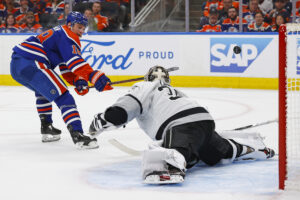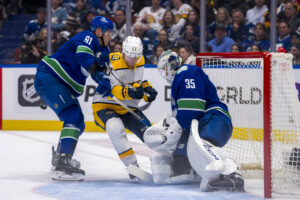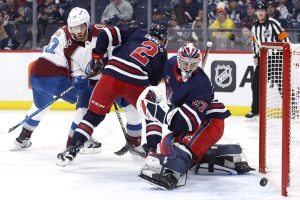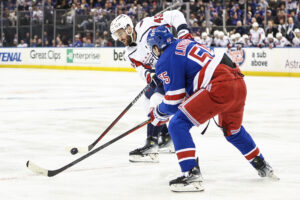Flyers rookie center Nolan Patrick had an up-and-down first NHL season. The surgery he had during the summer certainly impacted his play. Furthermore, there is always an adjustment when a player makes the jump from juniors to the NHL. For the first half of the season, Patrick looked to be a bit out of his depth. He did not appear to have his legs back and it showed.
Countless times from October through the end of December, he looked only a little bit faster than the not exactly fleet of foot Jori Lehtera. Flyers fans even clamored for Patrick to play in the World Junior Championship. Fortunately, Nolan Patrick’s season soon took a turn for the better.
Nolan Patrick: Disparity in Effectiveness
A quick glance shows that Patrick was far more effective in the second half of the season. In every single metric listed in the graph above, Patrick performed better. In fact, his performance in the second half of the season in some of these stats was substantially better. Specifically, his shot generation and high danger chance generation. Those hint at a player who was comfortable pushing the envelope a bit more.
Patrick’s goals per 60 scoring rate did not improve all that much, however. In effect, Patrick was shooting the puck a lot more but the number of goals he scored only improved a tiny bit. One would think that one of his homework assignments from Hextall over the summer was to work on his shot. Nevertheless, Patrick created exponentially more rebounds from his shots starting in January. Even if his shots were not going in, he was helping to create opportunities for his teammates via rebounds. Data included per NaturalStatTrick and OffsideReview.
Play Driving and Goal-Based Results
The gulf between Patrick’s underlying numbers from 2018 and 2017 is staggering. Relative stats compare Patrick’s advanced stats to his teammates. For example, there were 349 forwards who had at least 250 minutes of ice time from October through the end of December. Patrick ranked 345th in shot differential relative to team, 269th in goal differential relative to team, and 337th in expected goal differential relative to the team (per OffsideReview). It is not hyperbole to suggest that Nolan Patrick was one of the most ineffective forwards in the NHL from October through December.
Patrick’s 2018 results tell a completely different story. For instance, 167 NHL forwards logged at least 500 minutes of ice time from January through the end of the regular season. Patrick ranked 21st in shot differential relative to team, 36th in goal differential relative to team, and 15th in expected goal differential relative to the team. His team outshot, outscored, and won the shot quality battle when he was on the ice compared to when he was on the bench. As the graph shows, the team performed significantly better in those three facets of the game with Patrick on the ice.
Passing, Shooting, and Expected Offensive Production
Ryan Stimson’s passing project’s findings are fairly promising. Stimson’s work is fascinating because he delves into the importance of pre-shot movement. What happens prior to a shot is valuable information for coaches when constructing set plays and an offensive system as a whole. Which player (or players) have the ability to consistently draw defenders to them in order to create space for their teammates? Who excels in creating passes that directly lead to shots? Who can get off a hard and accurate one-timer?
Furthermore, one-timers have been found to be the most dangerous non-tip shots in the NHL. All of the above are vital pieces of information for a coaching staff. Patrick performs admirably when one examines his one-timer shot contributions. Having that shot in his toolkit will be vital moving forward.
Stimson has found that Expected Primary Points is more predictive of future scoring than points. Patrick was passable via Expected Primary Points per 60. It wouldn’t be unreasonable to suspect his numbers would be lower if he hadn’t turned things around in January.
Exits, Entries, & Primary Shot Contributions
Completing controlled exits and entries is an essential skill for forwards. Moreover, research shows how important controlled exits and entries are. Exiting the puck with possession or finding an available outlet was not one of Patrick’s strong suits during his rookie year. Grading out in the 23rd percentile is not ideal. Conversely, Patrick’s performance by controlled entries was passable. Relying on his teammates less to exit the zone is an area where Patrick stands to improve. His Primary Shot Contributions (shots & primary shot assists) were commendable as well.
The Future
Patrick was a different player in April than he was in October. A healthy off-season of training is something he hasn’t had in years. A few things to expect from him during the 2018-2019 season: more effective in tight, stronger in board/puck battles, faster, a harder and more accurate shot, and an even greater understanding of his defensive responsibilities. Fans should expect a 40-50 point season from Nolan Patrick in 2018-2019.
Data courtesy of: NaturalStatTrick, OffsideReview, Ryan Stimson, & Corey Sznajder.
Main Photo
Embed from Getty Images






